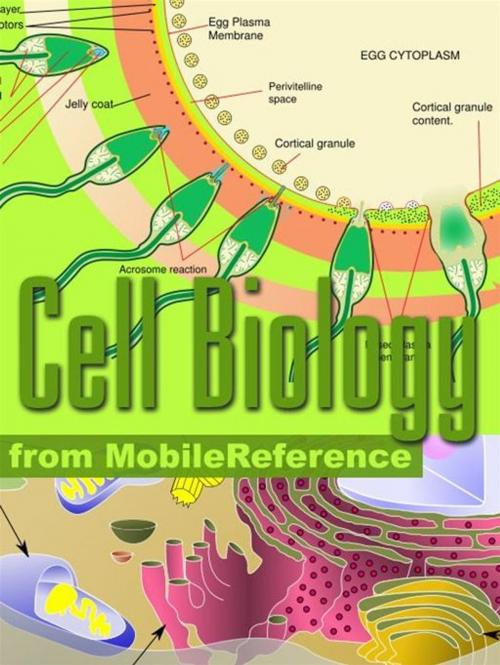Cell Biology Study Guide: Prokaryotes, Archaea, Eukaryotes, Viruses, Cell Components, Respiration, Protein Biosynthesis, Cell Division, Cell Signaling & More. (Mobi Study Guides)
Nonfiction, Science & Nature, Science, Biological Sciences, Cytology, Reference & Language, Study Aids, Reference| Author: | MobileReference | ISBN: | 9781605011080 |
| Publisher: | MobileReference | Publication: | January 1, 2010 |
| Imprint: | MobileReference | Language: | English |
| Author: | MobileReference |
| ISBN: | 9781605011080 |
| Publisher: | MobileReference |
| Publication: | January 1, 2010 |
| Imprint: | MobileReference |
| Language: | English |
Cell Biology Study GuideAudience: Intended for everyone interested in Biology, particularly undergraduate and graduate life science students, medical students, nursing, and dental students.FEATURES:- Fully illustrated- Written in clear, concise format. - Difficult concepts are explained in simple terms. - Detailed description on cell components and biochemical processes. - Navigate from Table of Contents or search for the words or phrases- Access the guide anytime, anywhere - at home, on the train, in the subway. - Use your down time to prepare for an exam. - Always have the guide available for a quick reference. TABLE OF CONTENTS:Cell: Cell membrane Cytoskeleton Genetic material Organelles Prokaryotic cells Eukaryotic cells Growth and metabolism Creation of new cells Protein synthesis Origins of cells HistoryTypes of Cells: Prokaryotes Bacteria Groups Gram-positive Gram-negative Cyanobacteria Archaea Eukaryotes Comparison of eukaryotic and procariotic cells Plant Cells Comparison of animal and plant cellsBacterial cell structure: Cell envelope Cytoplasmic membrane Surface structures Intracellular structures EndosporesCell Components: Cell wall Cell membrane Chloroplast Cilium Centriole Centrosome Glyoxysome Cytoplasm Cytoskeleton Endoplasmic reticulum Flagellum Golgi apparatus Lysosome Melanosome Mitochondria Mitotic spindle Nucleus Nucleolus Peroxisome Plasmodesmata Plastid Ribosome Vacuole VesicleCellular Respiration: Aerobic respiration Theoretical yields Anaerobic respiration Fermentation ATPMitochondria: Functions Oxidative phosphorylation Oxidative decarboxylation Electron transport Mitochondrial DNA Reproduction OriginPhotosynthesis: Chloroplast Plastid Plant photosynthesis Photosynthesis in algae and bacteria Discovery Molecular production Bioenergetics Factors affecting photosynthesis Light reaction Dark reaction Carbon Fixation Calvin cycle Pigments: Chlorophyll Carotenoids Xanthophyll Cytochrome Phycobilin BacteriorhodopsinCytoskeleton: Actin Myosin Intermediate filament Flagellin Microtubule Kinesin Dynein Cell MovementCell Membrane: Phospholipids Cholesterol Diffusion Osmosis Electrochemical gradient Membrane permeability Passive transport Facilitated diffusion Ion channel Active transport The ATP-Dependent Na/K Pump V-ATPase Exocytosis Endocytosis Cell wall Cell envelope Chitin PeptidoglycanCell Adhesion: Families of cell adhesion molecules Immunoglobulin Family Integrins Cadherin SelectinGenome: Gene Chromosomes Homologous chromosomes Karyotype Locus Chromatin: Euchromatin Heterochromatin Histone Nucleosome Somatic Cell Gametes: Ovum Sperm Human GenomeDNA: DNA replication Topoisomerase Helicase DNA Polymerase Replication fork Homologous Recombination Mitochondrial DNA Genetic code Gene expression DNA Repair Recombinant DNA Antisense
Cell Biology Study GuideAudience: Intended for everyone interested in Biology, particularly undergraduate and graduate life science students, medical students, nursing, and dental students.FEATURES:- Fully illustrated- Written in clear, concise format. - Difficult concepts are explained in simple terms. - Detailed description on cell components and biochemical processes. - Navigate from Table of Contents or search for the words or phrases- Access the guide anytime, anywhere - at home, on the train, in the subway. - Use your down time to prepare for an exam. - Always have the guide available for a quick reference. TABLE OF CONTENTS:Cell: Cell membrane Cytoskeleton Genetic material Organelles Prokaryotic cells Eukaryotic cells Growth and metabolism Creation of new cells Protein synthesis Origins of cells HistoryTypes of Cells: Prokaryotes Bacteria Groups Gram-positive Gram-negative Cyanobacteria Archaea Eukaryotes Comparison of eukaryotic and procariotic cells Plant Cells Comparison of animal and plant cellsBacterial cell structure: Cell envelope Cytoplasmic membrane Surface structures Intracellular structures EndosporesCell Components: Cell wall Cell membrane Chloroplast Cilium Centriole Centrosome Glyoxysome Cytoplasm Cytoskeleton Endoplasmic reticulum Flagellum Golgi apparatus Lysosome Melanosome Mitochondria Mitotic spindle Nucleus Nucleolus Peroxisome Plasmodesmata Plastid Ribosome Vacuole VesicleCellular Respiration: Aerobic respiration Theoretical yields Anaerobic respiration Fermentation ATPMitochondria: Functions Oxidative phosphorylation Oxidative decarboxylation Electron transport Mitochondrial DNA Reproduction OriginPhotosynthesis: Chloroplast Plastid Plant photosynthesis Photosynthesis in algae and bacteria Discovery Molecular production Bioenergetics Factors affecting photosynthesis Light reaction Dark reaction Carbon Fixation Calvin cycle Pigments: Chlorophyll Carotenoids Xanthophyll Cytochrome Phycobilin BacteriorhodopsinCytoskeleton: Actin Myosin Intermediate filament Flagellin Microtubule Kinesin Dynein Cell MovementCell Membrane: Phospholipids Cholesterol Diffusion Osmosis Electrochemical gradient Membrane permeability Passive transport Facilitated diffusion Ion channel Active transport The ATP-Dependent Na/K Pump V-ATPase Exocytosis Endocytosis Cell wall Cell envelope Chitin PeptidoglycanCell Adhesion: Families of cell adhesion molecules Immunoglobulin Family Integrins Cadherin SelectinGenome: Gene Chromosomes Homologous chromosomes Karyotype Locus Chromatin: Euchromatin Heterochromatin Histone Nucleosome Somatic Cell Gametes: Ovum Sperm Human GenomeDNA: DNA replication Topoisomerase Helicase DNA Polymerase Replication fork Homologous Recombination Mitochondrial DNA Genetic code Gene expression DNA Repair Recombinant DNA Antisense















